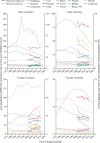Cancer statistics in China and United States, 2022: profiles, trends, and determinants
- PMID: 35143424
- PMCID: PMC8920425
- DOI: 10.1097/CM9.0000000000002108
Cancer statistics in China and United States, 2022: profiles, trends, and determinants
Abstract
Background: The cancer burden in the United States of America (USA) has decreased gradually. However, China is experiencing a transition in its cancer profiles, with greater incidence of cancers that were previously more common in the USA. This study compared the latest cancer profiles, trends, and determinants between China and USA.
Methods: This was a comparative study using open-source data. Cancer cases and deaths in 2022 were calculated using cancer estimates from GLOBOCAN 2020 and population estimates from the United Nations. Trends in cancer incidence and mortality rates in the USA used data from the Surveillance, Epidemiology, and End Results program and National Center for Health Statistics. Chinese data were obtained from cancer registry reports. Data from the Global Burden of Disease 2019 and a decomposition method were used to express cancer deaths as the product of four determinant factors.
Results: In 2022, there will be approximately 4,820,000 and 2,370,000 new cancer cases, and 3,210,000 and 640,000 cancer deaths in China and the USA, respectively. The most common cancers are lung cancer in China and breast cancer in the USA, and lung cancer is the leading cause of cancer death in both. Age-standardized incidence and mortality rates for lung cancer and colorectal cancer in the USA have decreased significantly recently, but rates of liver cancer have increased slightly. Rates of stomach, liver, and esophageal cancer decreased gradually in China, but rates have increased for colorectal cancer in the whole population, prostate cancer in men, and other seven cancer types in women. Increases in adult population size and population aging were major determinants for incremental cancer deaths, and case-fatality rates contributed to reduced cancer deaths in both countries.
Conclusions: The decreasing cancer burden in liver, stomach, and esophagus, and increasing burden in lung, colorectum, breast, and prostate, mean that cancer profiles in China and the USA are converging. Population aging is a growing determinant of incremental cancer burden. Progress in cancer prevention and care in the USA, and measures to actively respond to population aging, may help China to reduce the cancer burden.
Copyright © 2022 The Chinese Medical Association, produced by Wolters Kluwer, Inc. under the CC-BY-NC-ND license.
Conflict of interest statement
None.
Figures


References
-
- Bray F, Laversanne M, Weiderpass E, Soerjomataram I. The ever-increasing importance of cancer as a leading cause of premature death worldwide. Cancer 2021; 127:3029–3030. doi: 10.1002/cncr.33587. - PubMed
-
- Sung H, Ferlay J, Siegel RL, Laversanne M, Soerjomataram I, Jemal A, et al. . Global cancer statistics 2020: GLOBOCAN estimates of incidence and mortality worldwide for 36 cancers in 185 countries. CA Cancer J Clin 2021; 71:209–249. doi: 10.3322/caac.21660. - PubMed
-
- Wei W, Zeng H, Zheng R, Zhang S, An L, Chen R, et al. . Cancer registration in China and its role in cancer prevention and control. Lancet Oncol 2020; 21:e342–e349. doi: 10.1016/s1470-2045(20)30073-5. - PubMed
-
- Chen W, Zheng R, Baade PD, Zhang S, Zeng H, Bray F, et al. . Cancer statistics in China, 2015. CA Cancer J Clin 2016; 66:115–132. doi: 10.3322/caac.21338. - PubMed
-
- Siegel RL, Miller KD, Fuchs HE, Jemal A. Cancer statistics, 2022. CA Cancer J Clin 2022; 72:7–33. doi: 10.3322/caac.21708. - PubMed
MeSH terms
LinkOut - more resources
Full Text Sources
Medical

